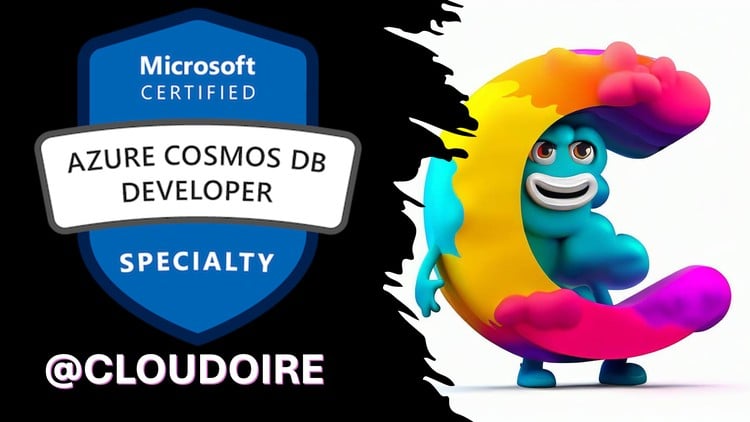What
You’ll Learn
You’ll Learn
- Create efficient data models and partition strategies tailored for scalability and performance in globally distributed applications.
- Configure access control
- encryption
- and compliance settings to protect data and meet regulatory standards.
- Monitor
- optimize
- and tune throughput
- indexing
- and consistency levels to meet performance and budgetary goals.
- Build applications using Azure Cosmos DB SDKs
- and integrate with services like Azure Functions
- Azure Logic Apps
- and Azure Event Grid.
Requirements
- Learners should have experience in cloud-based application development
- be familiar with Azure services
- and understand the basics of NoSQL databases and distributed systems.
Description
Skills at a glance
-
Design and implement data models (35–40%)
-
Design and implement data distribution (5–10%)
-
Integrate an Azure Cosmos DB solution (5–10%)
-
Optimize an Azure Cosmos DB solution (15–20%)
-
Maintain an Azure Cosmos DB solution (25–30%)
Design and implement data models (35–40%)
Design and implement a non-relational data model for Azure Cosmos DB for NoSQL
-
Develop a design by storing multiple entity types in the same container
-
Develop a design by storing multiple related entities in the same document
-
Develop a model that denormalizes data across documents
-
Develop a design by referencing between documents
-
Identify primary and unique keys
-
Identify data and associated access patterns
-
Specify a default time to live (TTL) on a container for a transactional store
-
Develop a design for versioning documents
-
Develop a design for document schema versioning
Design a data partitioning strategy for Azure Cosmos DB for NoSQL
-
Choose a partitioning strategy based on a specific workload
-
Choose a partition key
-
Plan for transactions when choosing a partition key
-
Evaluate the cost of using a cross-partition query
-
Calculate and evaluate data distribution based on partition key selection
-
Calculate and evaluate throughput distribution based on partition key selection
-
Construct and implement a synthetic partition key
-
Design and implement a hierarchical partition key
-
Design partitioning for workloads that require multiple partition keys
Plan and implement sizing and scaling for a database created with Azure Cosmos DB
-
Evaluate the throughput and data storage requirements for a specific workload
-
Choose between serverless, provisioned and free models
-
Choose when to use database-level provisioned throughput
-
Design for granular scale units and resource governance
-
Evaluate the cost of the global distribution of data
-
Configure throughput for Azure Cosmos DB by using the Azure portal
Implement client connectivity options in the Azure Cosmos DB SDK
-
Choose a connectivity mode (gateway versus direct)
-
Implement a connectivity mode
-
Create a connection to a database
-
Enable offline development by using the Azure Cosmos DB emulator
-
Handle connection errors
-
Implement a singleton for the client
-
Specify a region for global distribution
-
Configure client-side threading and parallelism options
-
Enable SDK logging
Implement data access by using the SQL language for Azure Cosmos DB for NoSQL
-
Implement queries that use arrays, nested objects, aggregation, and ordering
-
Implement a correlated subquery
-
Implement queries that use array and type-checking functions
-
Implement queries that use mathematical, string, and date functions
-
Implement queries based on variable data
Implement data access by using Azure Cosmos DB for NoSQL SDKs
-
Choose when to use a point operation versus a query operation
-
Implement a point operation that creates, updates, and deletes documents
-
Implement an update by using a patch operation
-
Manage multi-document transactions using SDK Transactional Batch
-
Perform a multi-document load using Bulk Support in the SDK
-
Implement optimistic concurrency control using ETags
-
Override default consistency by using query request options
-
Implement session consistency by using session tokens
-
Implement a query operation that includes pagination
-
Implement a query operation by using a continuation token
-
Handle transient errors and 429s
-
Specify TTL for a document
-
Retrieve and use query metrics
Implement server-side programming in Azure Cosmos DB for NoSQL by using JavaScript
-
Write, deploy, and call a stored procedure
-
Design stored procedures to work with multiple documents transactionally
-
Implement and call triggers
-
Implement a user-defined function
Design and implement data distribution (5–10%)
Design and implement a replication strategy for Azure Cosmos DB
-
Choose when to distribute data
-
Define automatic failover policies for regional failure for Azure Cosmos DB for NoSQL
-
Perform manual failovers to move single master write regions
-
Choose a consistency model
-
Identify use cases for different consistency models
-
Evaluate the impact of consistency model choices on availability and associated request unit (RU) cost
-
Evaluate the impact of consistency model choices on performance and latency
-
Specify application connections to replicated data
Design and implement multi-region write
-
Choose when to use multi-region write
-
Implement multi-region write
-
Implement a custom conflict resolution policy for Azure Cosmos DB for NoSQL
Integrate an Azure Cosmos DB solution (5–10%)
Enable Azure Cosmos DB analytical workloads
-
Enable Azure Synapse Link
-
Choose between Azure Synapse Link and Spark Connector
-
Enable the analytical store on a container
-
Implement custom partitioning in Azure Synapse Link
-
Enable a connection to an analytical store and query from Azure Synapse Spark or Azure Synapse SQL
-
Perform a query against the transactional store from Spark
-
Write data back to the transactional store from Spark
-
Implement Change Data Capture in the Azure Cosmos DB analytical store
-
Implement time travel in Azure Synapse Link for Azure Cosmos DB
Implement solutions across services
-
Integrate events with other applications by using Azure Functions and Azure Event Hubs
-
Denormalize data by using Change Feed and Azure Functions
-
Enforce referential integrity by using Change Feed and Azure Functions
-
Aggregate data by using Change Feed and Azure Functions, including reporting
-
Archive data by using Change Feed and Azure Functions
-
Implement Azure AI Search for an Azure Cosmos DB solution
Optimize an Azure Cosmos DB solution (15–20%)
Optimize query performance when using the API for Azure Cosmos DB for NoSQL
-
Adjust indexes on the database
-
Calculate the cost of the query
-
Retrieve request unit cost of a point operation or query
-
Implement Azure Cosmos DB integrated cache
Design and implement change feeds for Azure Cosmos DB for NoSQL
-
Develop an Azure Functions trigger to process a change feed
-
Consume a change feed from within an application by using the SDK
-
Manage the number of change feed instances by using the change feed estimator
-
Implement denormalization by using a change feed
-
Implement referential enforcement by using a change feed
-
Implement aggregation persistence by using a change feed
-
Implement data archiving by using a change feed
Define and implement an indexing strategy for Azure Cosmos DB for NoSQL
-
Choose when to use a read-heavy versus write-heavy index strategy
-
Choose an appropriate index type
-
Configure a custom indexing policy by using the Azure portal
-
Implement a composite index
-
Optimize index performance
Maintain an Azure Cosmos DB solution (25–30%)
Monitor and troubleshoot an Azure Cosmos DB solution
-
Evaluate response status code and failure metrics
-
Monitor metrics for normalized throughput usage by using Azure Monitor
-
Monitor server-side latency metrics by using Azure Monitor
-
Monitor data replication in relation to latency and availability
-
Configure Azure Monitor alerts for Azure Cosmos DB
-
Implement and query Azure Cosmos DB logs
-
Monitor throughput across partitions
-
Monitor distribution of data across partitions
-
Monitor security by using logging and auditing
Implement backup and restore for an Azure Cosmos DB solution
-
Choose between periodic and continuous backup
-
Configure periodic backup
-
Configure continuous backup and recovery
-
Locate a recovery point for a point-in-time recovery
-
Recover a database or container from a recovery point
Implement security for an Azure Cosmos DB solution
-
Choose between service-managed and customer-managed encryption keys
-
Configure network-level access control for Azure Cosmos DB
-
Configure data encryption for Azure Cosmos DB
-
Manage control plane access to Azure Cosmos DB by using Azure role-based access control (RBAC)
-
Manage control plane access to Azure Cosmos DB Data Explorer by using Azure role-based access control (RBAC)
-
Manage data plane access to Azure Cosmos DB by using Microsoft Entra ID
-
Configure cross-origin resource sharing (CORS) settings
-
Manage account keys by using Azure Key Vault
-
Implement customer-managed keys for encryption
-
Implement Always Encrypted
Implement data movement for an Azure Cosmos DB solution
-
Choose a data movement strategy
-
Move data by using client SDK bulk operations
-
Move data by using Azure Data Factory and Azure Synapse pipelines
-
Move data by using a Kafka connector
-
Move data by using Azure Stream Analytics
-
Move data by using the Azure Cosmos DB Spark Connector
-
Configure Azure Cosmos DB as a custom endpoint for an Azure IoT Hub
Implement a DevOps process for an Azure Cosmos DB solution
-
Choose when to use declarative versus imperative operations
-
Provision and manage Azure Cosmos DB resources by using Azure Resource Manager templates
-
Migrate between standard and autoscale throughput by using PowerShell or Azure CLI
-
Initiate a regional failover by using PowerShell or Azure CLI
-
Maintain indexing policies in production by using Azure Resource Manager templates
Who this course is for:
- This certification is ideal for developers and solution architects who design and build cloud-native applications that use Azure Cosmos DB as their primary data store.







